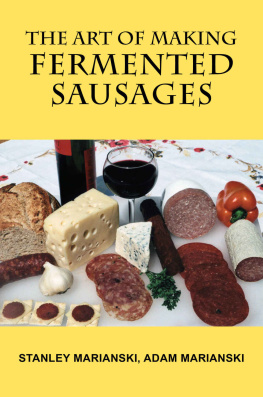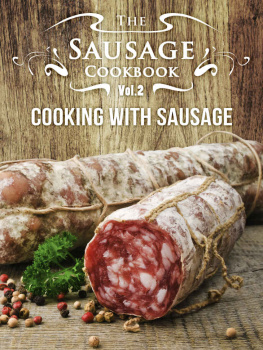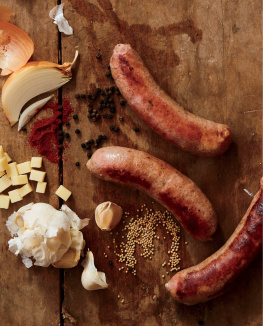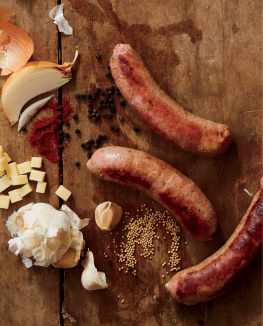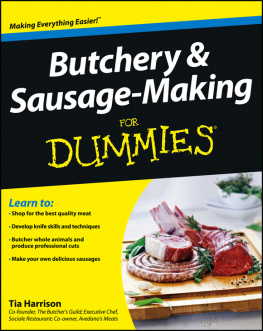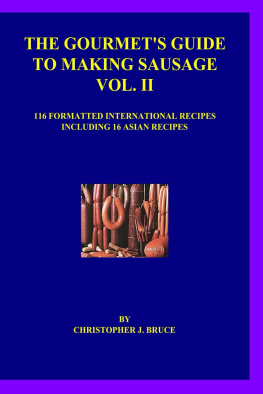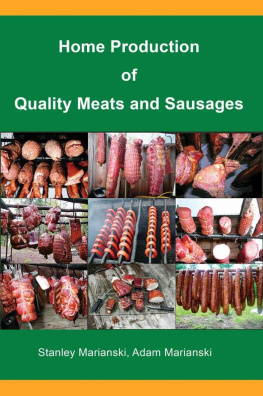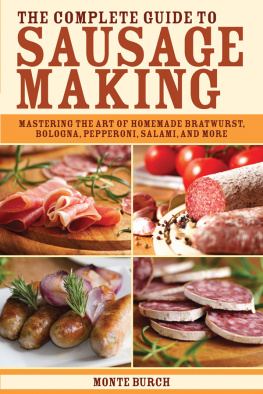HOME SAUSAGE MAKING
How-to Techniques for Making and Enjoying
100 Sausages at Home
Susan Mahnke Peery & Charles G. Reavis

The mission of Storey Publishing is to serve our customers by
publishing practical information that encourages
personal independence in harmony with the environment.
Edited by Dianne M. Cutillo
Art direction by Cynthia N. McFarland
Cover design by Carole Goodman, Blue Anchor Design
Illustrations by Elayne Sears
Text design by Carole Goodman, Blue Anchor Design,
Cynthia N. McFarland, and Susan Bernier
Text production by Jennifer Jepson Smith
Indexed by Susan Olason/Indexes & Knowledge Maps
1981, 1987, 2003 by Storey Publishing, LLC
Home Sausage Making was first published in 1981 and was revised in 1987. All of the information in the previous editions has been revised and updated. This edition includes new text and 68 new recipes.
All rights reserved. No part of this book may be reproduced without written permission from the publisher, except by a reviewer who may quote brief passages or reproduce illustrations in a review with appropriate credits; nor may any part of this book be reproduced, stored in a retrieval system, or transmitted in any form or by any means electronic, mechanical, photocopying, recording, or other without written permission from the publisher.
The information in this book is true and complete to the best of our knowledge. All recommendations are made without guarantee on the part of the author or Storey Publishing. The author and publisher disclaim any liability in connection with the use of this information. For additional information, please contact Storey Publishing, 210 MASS MoCA Way, North Adams, MA 01247.
Storey books are available for special premium and promotional uses and for customized editions. For further information, please call 1-800-793-9396.
Printed in the United States by Malloy
20 19 18 17 16 15 14 13 12 11 10
Library of Congress Cataloging-in-Publication Data
Peery, Susan Mahnke.
Home sausage making : how-to techniques for making and enjoying 100
sausages at home/Susan Mahnke Peery and Charles G. Reavis.
p. cm.
Includes index.
ISBN 978-1-58017-471-8 (alk. paper)
1. Cookery (Sausages) 2. Sausages. I. Reavis, Charles, 1948 II. Title.
TX749.5.S28 P44 2002
641.36dc21
2002015780
PREFACE
Like the first person to eat an oyster, historys first sausage maker is anonymous. But we owe this person a great debt, for sausage is up there with wine and cheese and bread as one of the worlds great foods. Sausage is more than just a way of preserving meat and using up the scraps. Sausage has been made for centuries in nearly every culture and country around the world, with great variation and ingenuity in taking advantage of local conditions and ingredients.
If you have never made sausage before, this book will walk you through the steps to successful sausage. Your neighbors, friends, and relatives will not only be impressed they will happen to show up for supper with amazing frequency! With minimal equipment, anyone can make a simple fresh sausage: Its like meatloaf stuffed into a casing.
For the more experienced sausage maker, we offer recipes for more than 100 different sausages, from fresh pork sausage to Old World cured and smoked specialties. Game sausage from venison and rabbit to bear and boar will please the hunters among us. (Come to think of it, no doubt that first sausage maker was a hunter faced with hundreds of pounds of woolly mammoth, yards of intestines, and the prospect of a long winter.)
If you are a vegetarian or prefer poultry or seafood, we offer more than three dozen recipes for making these new and delicious sausages.
Once you get the hang of sausage making, your own ingenuity will lead you even farther along this culinary path. We hope that you will utilize the response card bound into this book and let us know about your own adventures in sausage making.
Part One
The Techniques
CHAPTER 1
The Story of Sausage
Everything has an end except a sausage,
which has two.
Danish proverb
SAUSAGE WAS BORN OF NECESSITY, a way of preserving meat in times of plenty to eat when life turned lean. The fact that it tasted good, made efficient use of a slaughtered animal, and could be seasoned and shaped according to the sausage makers taste meant sausage was a real keeper in the larder, right next to cheese, wine, beer, dried lentils, raisins, and other staples.
When you make your own sausage, fresh or cured, you are in good company. Homer mentioned the Greeks love for grilled sausage in the Odyssey. The legionnaires of Imperial Rome wouldnt march without their little bottles of garum (a fermented fish sauce similar to todays nam pla from Thailand) and long strings of dried or smoked sausages.
Sausage making really took off in Europe during the medieval period, when an energetic spice trade and returning Crusaders brought exotic seasonings and new cooking techniques to sleepy farms and villages. Medieval towns all across Europe Bologna, Frankfurt, Vienna, and many others gave their names to distinctive sausages we still love. In North America, Native Americans dried and smoked venison and buffalo meat to make jerky, and they stuffed meat, suet, and berries into skins to make pemmican.
Sausage, part of the original portable feast, still delights our palates. It is a sturdy, nourishing comfort food, a link to the past. And when we make our own sausage, choosing ingredients and styles that please ourselves, our families, and our friends, the possibilities are, well, endless.
SAUSAGE BASICS
There are literally thousands of varieties of sausage in the world, but the United States Department of Agriculture groups them all into two types: uncooked, including fresh bulk sausage, patties, links, and some smoked sausages; and ready-to-eat, including dry, semidry, and/or cooked sausages.
Fresh sausages must be cooked before they are eaten. Like other fresh meat, they are highly perishable and must be refrigerated or frozen until you are ready to cook them. Ready-to-eat sausages are cooked and/or preserved with ingredients such as salt, nitrites (now closely regulated), and alcohol, and they may be dried and/or smoked to further prevent spoilage. These sausages can be eaten out of hand (a slice of pepperoni, for instance), or cooked just enough to heat through (a frankfurter, for example).
By our definition, sausage is a mixture of ground meat and (usually) fat, poultry, seafood, or vegetarian ingredients laced with salt, herbs, and spices. A sausage mixture can be shaped into a patty and fried like a burger or it can be stuffed into a casing. Once stuffed and twisted into links, it may be cooked on the spot or dried, smoked, fermented, or otherwise preserved.
Stuffing may seem like a lot of extra work, especially for fresh sausage, but it is worth it. Beyond giving the sausage its characteristic shape, the casing helps to improve the texture of the finished product and meld the flavors. That sublimely satisfying moment of biting into a hot, juicy homemade sausage doesnt happen when you shape the mixture into patties instead.
It would be futile to try to catalog all of the varieties of sausage in the world, since some kinds are made only in a small region or even in a single household. As you learn to make your own sausages, you will begin to personalize your recipes, perhaps creating your own unique variety, and certainly adding to the dazzling array of sausages that have already been thought up in the human mind to please the human palate.



